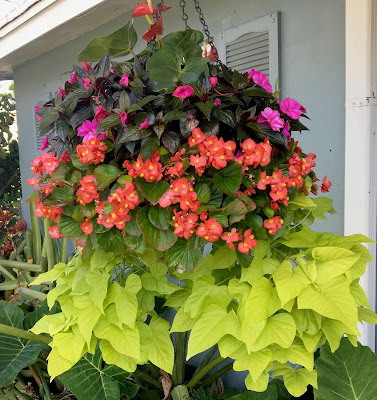
|
|
This is one of Jon VanZile's flower balls — and an example of one of his
garden hacks. (Photos courtesy Jon VanZile)
|
How do you transfer a tender seeding into garden soil? How do you grow more vegetables with greater success? How do you keep hungry iguanas from raiding the tomato patch?
Prompted by his book editor, longtime garden writer Jon VanZile compiled almost 350 of his favorite low- or no-budget DIY hacks to common garden issues. (Although he’s had plenty of experience, he left out his just-for-iguana tips.)
The result is a fun and very useful new book: “Gardening Hacks: 300+ Time and Money Saving Hacks – All-Natural Solutions for Vegetables, Fruits, Flowers and More” (Adams Media, Simon and Schuster, 256 pages, $15.99).
Made for browsing, this handy paperback offers interesting ideas and tips on every page. Almost 50 pages are devoted to seed starting and propagation. Container and indoor gardening both have beefy chapters, crammed with “why didn’t I think of that?” solutions. Sections devoted to outdoor gardening and “tools, pests and harvest” recycle so many everyday items, you may never look at an empty container the same way again.
VanZile, a master gardener and former newspaper garden writer, reaped most of his tips from his own experience.
“I brainstormed with every cool idea I ever had,” he said in a phone interview. “I’ve been gardening my whole life. I started my first vegetable garden in middle school in the suburbs of Detroit – people thought I was crazy. I kept growing things all through college, with plants in my dorm room on my dresser. Then, I moved to South Florida.”

|
|
Jon VanZile is a longtime garden writer.
|
That’s when VanZile realized almost everything he thought he knew about gardening had to be relearned.
“I went from growing in Zone 5 to Zone 10, 60 inches of rain and different soil,” recalled VanZile, who now lives in Fort Lauderdale.
VanZile went through South Florida master gardener training so he could cope with his own transplanting. Then he turned his attention to tomatoes.
Something that Sacramento (or Michigan) gardeners take for granted was almost impossible to grow in South Florida.
“Our growing season down here is October to May,” he explained. “We’re just wrapping up harvest now.”
That’s not good if you love the taste of homegrown tomatoes.
“For awhile, I was really into tomatoes,” VanZile said. “I couldn’t find information on how to grow to tomatoes in the sub-tropics. So I started a blog on that.”
Going to elaborate extremes to harvest an often meager tomato crop, VanZile quickly found an audience.
“It became the world’s number one blog in that one very narrow niche,” he said. “I had lots of readers in India. Tomatoes are very hard to grow here. It’s the humidity, and we’re completely overrun with iguanas.”
That’s a regional issue Sacramento gardeners rarely encounter.
“People get them as pets – they’re these cute little green lizards,” VanZile said. “But they turn into these 3-foot-long monsters that hate you and eat everything. So they let them go.”
VanZile’s home is adjacent to one of Fort Lauderdale’s canals, which have become home to these voracious invaders.
“On our seawall, there will be 15, 20 iguanas lined up every day,” he said. “My dog goes out and barks at them and scares them off the seawall, then they come back a little later. This goes on all day.”
To ward off iguanas, VanZile has to cover everything in his vegetable garden with screens or suspend plants to grow off the ground where iguanas can’t reach. (That same tactic can work in warding off squirrels or rabbits.)
Gardening success is an intensely local topic, he noted. Instead of including ways to outsmart iguanas, he focused on more common experiences and issues in his book.
“I concentrated on universal topics like starting seeds,” he said. “There’s something in there for everybody and at every skill level. Some things are very simple, others more advanced.”
The more advanced projects include the creation of “flower balls,” containers planted with annuals all around to form a globe of blooms. (The toughest part? Keeping it watered.)
His favorite hacks involve seed starting.
“Starting your own seeds is so important, especially for vegetable gardening,” he said. “You can grow so many things and you’re not limited to what’s available at the local nursery. But how do you transfer that tiny fragile plant into the ground without hurting it?”
VanZile provides many, many possible solutions such as starting seeds in eggshells, creating your own seed blocks or making your own seed tape.
A great re-purposer as well as recycler, he uses honey to strengthen cuttings and makes all-natural pesticides and fertilizers from the kitchen pantry.
“Originally, the idea was how to spend less money and enjoy gardening more,” he added. “Gardening can be expensive – my tomatoes are proof.”


